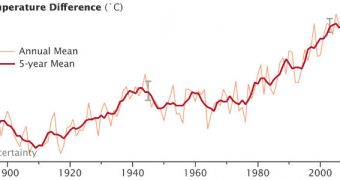According to an analysis compiled by investigators at the NASA Goddard Institute for Space Studies (GISS) in New York, average surface temperatures around the globe continued to increase throughout 2011, keeping in tune with climate scientists' predictions.
The team says that 9 of the 10 warmest years measured since weather records began being kept, in the 1880s, were recorded between 2000 and 2011, with last year being the 9th warmest. These meteorological records are the main source of data proving the existence of global warming.
GISS investigators are especially qualified to produce such datasets, and derive trends based on available data, simply because they are monitoring surface temperatures around the year. They have one of the most complete records in the world on how these temperatures evolve in time.
The main conclusion of their analysis is that our planet continues to warm up, even when compared to just a few decades ago. When compared to the mid-20th century baseline, average 2011 surface temperatures were about 0.92 degrees Fahrenheit (0.51ºC) higher.
2010 continues to remain the warmest year in the GISS record. The difference between 2010 and 2011 is only 0.22 degrees F (0.12ºC), which demonstrates just how much temperatures shift in just a year.
Experts at GISS are keen on reminding people that Earth's natural climate variations will not make every year warmer than the one before it. Rather, global warming is a trend that becomes clearly apparent upon analyzing longer-term trends, such as for example over decades.
“We know the planet is absorbing more energy than it is emitting. So we are continuing to see a trend toward higher temperatures,” explains James E. Hansen, who holds an appointment as the GISS director.
“Even with the cooling effects of a strong La Niña influence and low solar activity for the past several years, 2011 was one of the 10 warmest years on record,” he goes on to say. When La Niña's opposite, El Niño, kicks in, temperatures are bound to soar way above the long-term average.
“It's always dangerous to make predictions about El Niño, but it's safe to say we'll see one in the next three years. It won't take a very strong El Niño to push temperatures above 2010,” Hansen explains.
The weather data the GISS investigators used for their analysis include information collected from 1,000+ meteorological stations, satellite observations of sea surface temperature and Antarctic research station measurements, among other sources.
Carbon dioxide levels in the atmosphere have risen from 285 parts per million (ppm), in 1880, to 390 ppm today. It is estimated that an increase above 400 ppm will cause irreversible damage to our planet.

 14 DAY TRIAL //
14 DAY TRIAL //